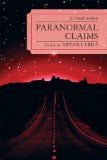 Paranormal Claims: A Critical Analysis
Paranormal Claims: A Critical Analysis
by Bryan Farha
University Press of America, £18.99, ISBN 0-7618-3772-8
An anthology of skeptical writings that includes contributions by James Randi, Michael Shermer and Carl Sagan is not likely to go far wrong, but that last name will alert skeptics to the fact that some of these texts are far from recent. In fact, nearly everything in the book is reprinted from The Skeptical Inquirer, or [the other] Skeptic. Some are taken from the excellent quackwatch.org website.
Among other chapters, Shermer asks “Why Smart People Believe Weird Things”, Ray Hyman explains cold reading, Susan Blackmore delves into near-death experiences, Randi recounts his experiences with his demolition of homeopathy on BBC TV’s Horizon, and Geoffrey Dean astutely reviews the sorry state of astrology. It is very pleasing to read a paper from the Journal of the American Medical Association, co-authored by Emily Rosa, who devised a test when she was only nine years old that ruined the case for “therapeutic touch”.
There are 18 articles altogether. Naturally, the more such analyses are disseminated and read, the better, and subscribers to the above journals will no doubt be glad to re-read these articles in book form. Reluctantly, then, I venture a quibble or two. Professor Farha calls this a critical analysis, which is fair enough, as it instructively and often amusingly leads us around the usual fairground of irrationalities, but it doesn’t seem quite right for the publisher to call it an academic text: one of Farha’s own efforts is a jokey piece about numerology, and Randi’s account of his invaluable TV show is hardly the stuff of learned journals. It may then be better targeted at what used to be called “the intelligent layman”, or, more urgently, at young people in need of a handy antidote to the effluents of New Age whimsy. If so, it’s a shame that this 167-page book is both far too big and far too expensive for the average pocket.
Paul Taylor

